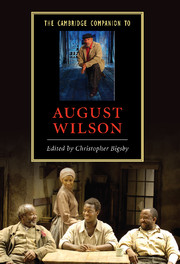Book contents
- Frontmatter
- 1 August Wilson: the ground on which he stood
- 2 Been here and gone
- 3 August Wilson’s relationship to black theatre: community, aesthetics, history and race
- 4 Music and mythology in August Wilson’s plays
- 5 Gem of the Ocean and the redemptive power of history
- 6 Joe Turner’s Come and Gone
- 7 Ma Rainey’s Black Bottom: cutting the historical record, dramatizing a blues CD
- 8 A piano and its history: family and transcending family
- 9 The tragedy of Seven Guitars
- 10 Safe at home?: August Wilson’s Fences
- 11 Two Trains Running: blood on the tracks
- 12 Jitney, folklore and responsibility
- 13 King Hedley II: in the midst of all this death
- 14 Radio Golf: the courage of his convictions - survival, success and spirituality
- 15 Critics on August Wilson
- 16 An interview with August Wilson
- Index
8 - A piano and its history: family and transcending family
Published online by Cambridge University Press: 28 January 2008
- Frontmatter
- 1 August Wilson: the ground on which he stood
- 2 Been here and gone
- 3 August Wilson’s relationship to black theatre: community, aesthetics, history and race
- 4 Music and mythology in August Wilson’s plays
- 5 Gem of the Ocean and the redemptive power of history
- 6 Joe Turner’s Come and Gone
- 7 Ma Rainey’s Black Bottom: cutting the historical record, dramatizing a blues CD
- 8 A piano and its history: family and transcending family
- 9 The tragedy of Seven Guitars
- 10 Safe at home?: August Wilson’s Fences
- 11 Two Trains Running: blood on the tracks
- 12 Jitney, folklore and responsibility
- 13 King Hedley II: in the midst of all this death
- 14 Radio Golf: the courage of his convictions - survival, success and spirituality
- 15 Critics on August Wilson
- 16 An interview with August Wilson
- Index
Summary
What time or period is the setting for The Piano Lesson (1987)? That was the first question asked by the late great Chinese actor and director Ying Ruocheng (1921-2003) after he read the play in 1991. The question surprises those who know that each play in August Wilson's ten-play cycle depicting African American experience is set in a different decade of the twentieth century. If the historical period is part of the basic concept underlying each play, the temporal setting should be evident. Indeed, a stage production communicates the time of the action to the spectator almost immediately through period-specific details like the appliances in the kitchen and the dresses the women wear. Wilson's printed text, however, is curiously reticent in conveying such information. The reader of the play does have an advantage over the theatre spectator. He or she can pause and calculate, as Ying eventually did, using the data woven into Doaker's story about the piano. Doaker's older brother, Boy Charles, 'would have been fifty-seven if he had lived. He died in 1911 when he was thirty-one years old.' If the action of the play occurs twenty-six years after 1911, it must be 1936 or 1937.
A reference to 1930s America usually conjures images of the Great Depression: breadlines, Hoovervilles, the Dust Bowl, WPA projects. That Wilson sets his play in the latter part of the decade and hoists none of those cultural flags is surely deliberate. The economic depression of the 1930s hit hardest those who had bought into the prosperity of the 1920s, but African Americans - not having experienced much, if any, of that prosperity - moved into the 1930s under already familiar financial constraints. The view from inside the Charles home in Pittsburgh is one of cultural continuity; there is no reason for them to talk about changes that affect people outside their culture.
- Type
- Chapter
- Information
- The Cambridge Companion to August Wilson , pp. 113 - 123Publisher: Cambridge University PressPrint publication year: 2007
- 1
- Cited by



